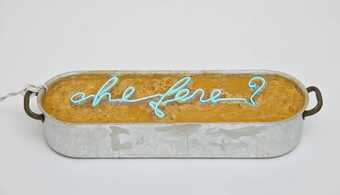The works in these rooms explore the use of written language in art
People have used language as an expressive art form for millennia, from oral tradition and the spoken word, to illuminated manuscripts and printed publications. This room brings together works produced in the last 50 years in Europe and the USA. They demonstrate different ways of engaging with text and its role as a form of communication.
By the late 1960s, text was the primary focus of many visual artworks. Artists associated with movements like cubism and Pop Art had long incorporated words found in advertising and mass media. Those interested in concrete poetry (such as Ian Hamilton Finlay) and conceptual art (such as Lawrence Weiner) often made artworks from text alone.
Many of the works in this room respond directly to the proliferation of language and text in the information age, particularly in relation to consumerism. For some artists, text provides a unique way to translate and materialise their ideas. Others reflect on language as an expression of human culture, capable of transmitting ideas, influencing behaviour and memorialising people and events.
Some of these artists focus on the act of writing as a form of making: inscribing, painting, carving, scribbling, typing or embroidering words as personal, meditative and poetic acts. For many, text-based works are a way to actively engage viewers. The reader is invited to imagine what is only described, and to project their own memories and associations onto the artist’s words.

